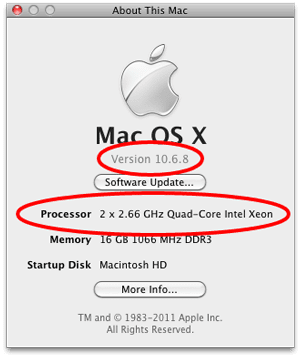 Mac OS X 10.6 Snow Leopard came out on Friday, and there’s been quite a big hullabaloo about the fact that – by default – Apple’s new OS boots into 32-bit mode on almost all Macs, with the only exceptions being the 2008 and 2009 XServe.
Mac OS X 10.6 Snow Leopard came out on Friday, and there’s been quite a big hullabaloo about the fact that – by default – Apple’s new OS boots into 32-bit mode on almost all Macs, with the only exceptions being the 2008 and 2009 XServe.
Before we gather our pitchforks and torches to go surround One Infinite Loop, let’s take a step back and take a look at a few points that people seem to keep missing.
- 32-bit mode enables compatibility. At this point, we’re still in transition. While most, if not all, of Apple’s kernel extensions (KEXTs) are all 64-bit, there are still many third-parties that have yet to catch up. If the kernel was set to 64-bit, then all the 32-bit KEXTs would not load, thus “breaking” many third party utilities and peripherals.
- Snow Leopard can run 64-bit applications. Even though the kernel itself is running in 32-bit mode, most of that which we use every day are 64-bit apps. Apps like Safari, Mail, iCal, and – most importantly – the Finder itself, all run in 64-bit mode. About the only Apple apps not running in 64-bit are the iLife apps, which will likely see an update soon. 64-bit versions of third-party applications though, such as Photoshop, will also be released over time from their respective vendors.
- 64-bit isn’t the only speed boost. While a lot of attention has been paid to the 64- vs. 32-bit difference, Snow Leopard has a number of new technologies that will also help speed things up. Two such examples are Grand Central Dispatch and OpenCL. Grand Central Dispatch will make it easier for developers to utilize multiple processor cores – something the vast majority of Intel Macs have. OpenCL allows applications to use the power of the GPU in your computer. While only a few cards are currently supported, it is entirely possible that others will be added to this list in the future.
- Snow Leopard is about the future, not the present. A more accurate way to describe Snow Leopard is as a transitional release. It provides a solid framework for developers to incorporate the above-mentioned technologies as they update their applications. Once they do, there should be an increase in efficiency. As more and more drivers are converted over to 64-bit, then the need for the 32-bit kernel will reduce. At that point, we may see an official utility to switch 64-bit mode on/off.
Until the point we have nothing but 64-bit compatible KEXTs, though, a 32-bit kernel with the capability of running 64-bit applications seems to be a reasonable compromise. Since the Finder and many of the other Applications we run are 64-bit, we will see a speed boost from that, even though the kernel is 32-bit. Once everything else is updated to 64-bit, I would not be surprised if an official option to more permanently enable the 64-bit kernel emerges.
While, personally, the potential compatibility headaches are enough to keep me with the default 32-bit kernel on my MacBook Pro, I realize there are still many out there that want to try and wring every last bit of performance out of their machines (I know, I’m usually one of them) who will insist on booting their systems to the 64-bit kernel. So, in case you haven’t already found out how to do it, I’ll give you a couple of options.
- The easiest way to do it is to hold down the 6 and 4 keys at startup and release them when you reach the login screen or desktop. However, this will revert to 32-bit on restart unless you hold down 6 and 4 again.
- For a little more control over which kernel you use (allowing you to make booting to 64-bit a little more “permanent”) you may want to check into Startup Mode Selector. It’s a free application (though donations are accepted) that lets you set which kernel you want to boot with. If you’re going to go this route and boot to 64-bit “permanently,” I highly recommend you read the accompanying information on the author’s Web site.










What gives with the Chicken?
It was a visual reference to the “Chicken Little/The Sky is Falling” attitude many were adopting regarding to Snow Leopard not booting into full 64-bit mode in most machines.
This article was presented as a counter to that.